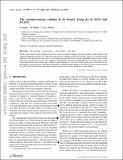Files in this item
The rotation–activity relation of M dwarfs : from K2 to TESS and PLATO
Item metadata
| dc.contributor.author | Raetz, Stefanie | |
| dc.contributor.author | Stelzer, Beate | |
| dc.contributor.author | Scholz, Alexander | |
| dc.date.accessioned | 2021-06-24T23:35:46Z | |
| dc.date.available | 2021-06-24T23:35:46Z | |
| dc.date.issued | 2020-08-27 | |
| dc.identifier | 268938802 | |
| dc.identifier | 9d05cf58-dbd8-45e8-9b0b-48cb8dea84c2 | |
| dc.identifier | 85087218091 | |
| dc.identifier | 000563771700007 | |
| dc.identifier.citation | Raetz , S , Stelzer , B & Scholz , A 2020 , ' The rotation–activity relation of M dwarfs : from K2 to TESS and PLATO ' , Astronomische Nachrichten , vol. 341 , no. 5 , pp. 519-556 . https://doi.org/10.1002/asna.202013727 | en |
| dc.identifier.issn | 0004-6337 | |
| dc.identifier.other | RIS: urn:6723C317AE34892E73CCE01E030AB39C | |
| dc.identifier.uri | https://hdl.handle.net/10023/23419 | |
| dc.description.abstract | Studies of the rotation–activity relation of late‐type stars are essential to enhance our understanding of stellar dynamos and angular momentum evolution. We study the rotation–activity relation with K2 for M dwarfs, where it is especially poorly understood. We analyzed the light curves of all bright and nearby M dwarfs form the Superblink proper motion catalog that were in the K2 field of view. Using a sample of 430 M dwarfs observed in campaigns C0–C19 in long‐cadence mode, we determined the rotation period and a wealth of activity diagnostics. Our study of the rotation–activity relation based on photometric activity indicators confirmed the previously published abrupt change of the activity level at a rotation period of ∼10 days. Our sample, which is more than three times larger, increases the statistical significance of this finding. | |
| dc.format.extent | 2462409 | |
| dc.language.iso | eng | |
| dc.relation.ispartof | Astronomische Nachrichten | en |
| dc.subject | Stars: late-type | en |
| dc.subject | Stars: activity | en |
| dc.subject | Stars: rotation | en |
| dc.subject | Stars: flare | en |
| dc.subject | QB Astronomy | en |
| dc.subject | DAS | en |
| dc.subject.lcc | QB | en |
| dc.title | The rotation–activity relation of M dwarfs : from K2 to TESS and PLATO | en |
| dc.type | Journal article | en |
| dc.contributor.institution | University of St Andrews. School of Physics and Astronomy | en |
| dc.contributor.institution | University of St Andrews. St Andrews Centre for Exoplanet Science | en |
| dc.identifier.doi | https://doi.org/10.1002/asna.202013727 | |
| dc.description.status | Peer reviewed | en |
| dc.identifier.url | https://arxiv.org/abs/2005.08688 | en |
This item appears in the following Collection(s)
Items in the St Andrews Research Repository are protected by copyright, with all rights reserved, unless otherwise indicated.

